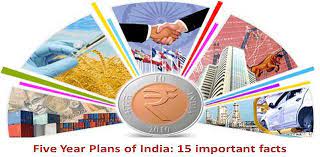Five Year Plans in India are a series of social and economic development plans that were implemented by the government of India. The plans are formulated for a five-year period and aimed to achieve specific objectives related to the growth of the Indian economy. In this blog, we’ll discuss the history, objectives, achievements, and criticisms of the Five Year Plans in India.

Table of Contents
History of Five Year Plans in India
The First Five Year Plan was launched in 1951 under the leadership of Jawaharlal Nehru. Since then, India has implemented twelve Five Year Plans, with the last one being the Twelfth Five Year Plan, which ended in 2017.
Objectives of Five Year Plans in India
The Five Year Plans were designed to achieve specific objectives related to economic growth, social development, and poverty alleviation. The objectives of each plan varied based on the prevailing economic conditions and the priorities of the government at the time. Some of the key objectives of the Five Year Plans included increasing agricultural production, developing infrastructure, promoting industrialization, and reducing poverty.
Achievements of Five Year Plans in India
The Five Year Plans have played a significant role in India’s economic and social development over the years. The plans have helped to improve the country’s infrastructure, increase agricultural production, and promote industrialization. The Five Year Plans have also led to significant improvements in the country’s social indicators, including literacy rates, life expectancy, and access to basic healthcare.
Criticisms of Five Year Plans in India
While the Five Year Plans have achieved some notable successes, they have also faced criticism. Some of the common criticisms include the plans’ focus on quantitative targets, which led to a neglect of quality concerns. The Five Year Plans have also been criticized for their failure to address issues related to income inequality and poverty.
First Five Year Plan (1951-1956)
- Agriculture and land reform
- Community development
- Power and irrigation
- Transport and communication
- Development of basic industries
- Social services like education and healthcare
Second Five Year Plan (1956-1961)
- Rapid industrialization
- Promotion of public sector enterprises
- Agricultural growth
- Community development
- Expansion of transport and communication
- Social services like education and healthcare
Third Five Year Plan (1961-1966)
- Expansion of heavy industries
- Import substitution
- Agricultural modernization
- Improvement of rural infrastructure
- Family planning and population control
- Social services like education and healthcare
Fourth Five Year Plan (1969-1974)
- Growth with stability
- Employment generation
- Agricultural growth
- Modernization of industries
- Poverty alleviation
- Social services like education and healthcare
Fifth Five Year Plan (1974-1979)
- Removal of poverty and unemployment
- Modernization of industries
- Agricultural growth
- Expansion of social services
- Community development
- Rural electrification
Sixth Five Year Plan (1980-1985)
- Rural development
- Increase in food production
- Stabilization of prices
- Employment generation
- Development of infrastructure
- Modernization of industries
Seventh Five Year Plan (1985-1990)
- Increasing productivity
- Modernization of industries
- Development of infrastructure
- Employment generation
- Growth of exports
- Social services like education and healthcare
Eighth Five Year Plan (1992-1997)
- Human resource development
- Increasing productivity
- Poverty alleviation
- Infrastructure development
- Development of agriculture and rural industries
- Modernization of industries
Ninth Five Year Plan (1997-2002)
- Growth with social justice
- Poverty alleviation
- Infrastructure development
- Employment generation
- Agricultural development
- Social services like education and healthcare
Tenth Five Year Plan (2002-2007)
- Accelerated economic growth
- Employment generation
- Infrastructure development
- Agricultural development
- Education and healthcare
- Regional development
Eleventh Five Year Plan (2007-2012)
- Inclusive growth
- Infrastructure development
- Skill development and employment generation
- Environment sustainability
- Social services like education and healthcare
- Rural development
Twelfth Five Year Plan (2012-2017)
- Faster, sustainable and more inclusive growth
- Infrastructure development
- Inclusive social development
- Governance reforms
- Skill development and employment generation
- Environment sustainability.
In conclusion, the Five Year Plans in India have played a critical role in India’s economic and social development over the years. The plans have achieved significant successes, including improving infrastructure, increasing agricultural production, and promoting industrialization. However, the plans have also faced criticisms, particularly in the areas of quality concerns, income inequality, and poverty alleviation. The future of Five Year Plans in India remains uncertain, but it is clear that the plans have left a lasting impact on the country’s development.